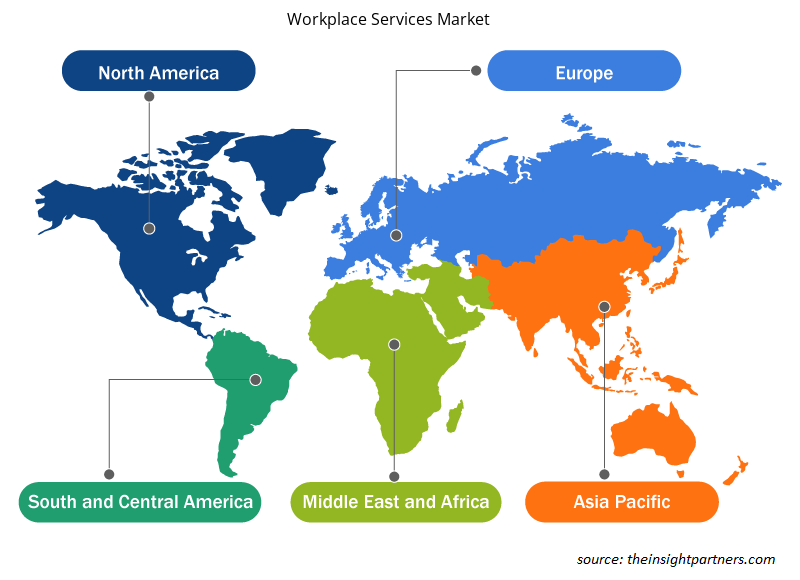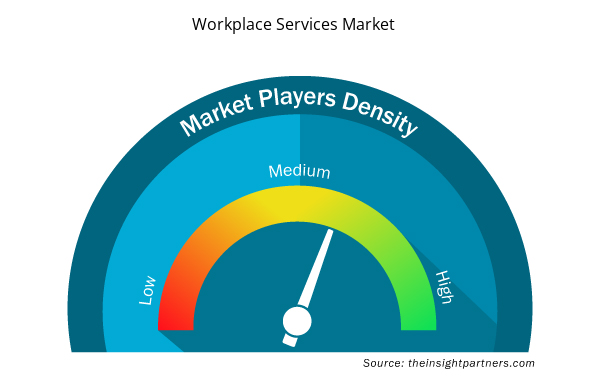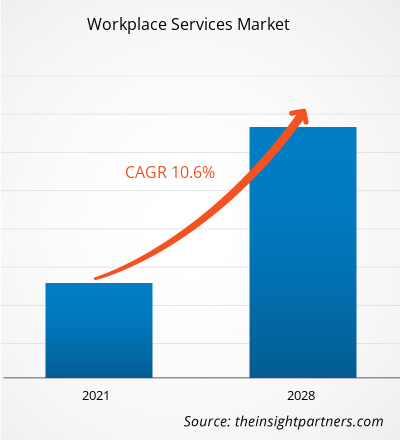Der Markt für Arbeitsplatzdienstleistungen wurde im Jahr 2020 auf 88,0 Milliarden US-Dollar geschätzt und soll bis 2028 193,4 Milliarden US-Dollar erreichen; von 2021 bis 2028 wird ein durchschnittliches jährliches Wachstum von 10,6 % erwartet.
Technologie bietet zahlreiche Vorteile für Unternehmen. Ein exponentielles Wachstum bei Anwendungen, Geräten und Netzwerken wirkt sich positiv auf die Arbeitskultur aus. Sicherere Arbeitsumgebungen, hybride Arbeitsplätze, zusätzliche Cybersicherheit und eine weltweit verteilte Belegschaft sind einige der Aspekte, die zum Konzept des modernen Arbeitsplatzes beitragen und damit das Wachstum von Arbeitsplatzdiensten beeinflussen. Daher verlangen die gut etablierte IT-Infrastruktur und kleine, mittlere und große Unternehmen in allen Regionen nach Arbeitsplatzdiensten. Es wird erwartet, dass Unternehmen aller Größen in innovative und neueste Technologien investieren, um ihr Geschäft effektiv zu betreiben. Unternehmen auf der ganzen Welt nutzen Arbeitsplatzdienste, um ihr Geschäft anzukurbeln und ihre Geschäftsanstrengungen zu optimieren, um den geringstmöglichen Investitionsbedarf in verschiedenen Prozessen sicherzustellen.
Passen Sie diesen Bericht Ihren Anforderungen an
Sie erhalten kostenlos individuelle Anpassungen an jedem Bericht, einschließlich Teilen dieses Berichts oder einer Analyse auf Länderebene, eines Excel-Datenpakets sowie tolle Angebote und Rabatte für Start-ups und Universitäten.
- Holen Sie sich die wichtigsten Markttrends aus diesem Bericht.Dieses KOSTENLOSE Beispiel umfasst eine Datenanalyse von Markttrends bis hin zu Schätzungen und Prognosen.
Auswirkungen der COVID-19-Pandemie auf den Markt für Arbeitsplatzdienstleistungen
Die COVID-19-Pandemie hat mehrere Branchen erschüttert. Die enorme Zunahme der Verbreitung des Virus hat Regierungen weltweit dazu veranlasst, strenge Beschränkungen für die Bewegung von Fahrzeugen und Menschen zu verhängen. Aufgrund von Reiseverboten, Massensperren und Geschäftsschließungen wirkt sich die Pandemie negativ auf die Volkswirtschaften und unzählige Branchen in verschiedenen Ländern aus. Die Anbieter von Arbeitsplatzdiensten setzten ihre Aktivitäten aus der Ferne fort, um ihren Endbenutzern die besten Dienste anzubieten. Selbst während der Pandemie waren mehrere Marktteilnehmer weiterhin gut aufgestellt, um ihre Endbenutzer durch die Krise zu unterstützen. Die COVID-19-Pandemie hat Unternehmen dazu veranlasst, ihre digitale Transformation voranzutreiben, was zur Beseitigung traditioneller Hindernisse für den Fortschritt führt. Unternehmen helfen ihren Endbenutzern weiterhin, indem sie sich virtuell engagieren, Anwendungen modernisieren und in die Cloud migrieren, eine Remote-Belegschaft zulassen und sich auf Cybersicherheit und IT-Ausfallsicherheit konzentrieren.
Einblicke in den Markt für Arbeitsplatzdienste
Wachsende Bedeutung der Enterprise Mobility
Unternehmensmobilität ist ein weit gefasster Begriff, der mobile Virtualisierung, mobile Geräteverwaltung und mobile Virtualisierung umfasst, die die Produktivität steigern, Dienste verbessern und das Benutzererlebnis verbessern. Die Unternehmensmobilitätsbranche hat sich enorm entwickelt, da Unternehmen nach Diensten suchen, die alle Funktionen der mobilen Sicherheit abdecken können, von Geräten und Software bis hin zum Datenschutz. In der heutigen Zeit ist die Nachfrage nach Unternehmensmobilität in der Belegschaft auf dem Höhepunkt, insbesondere aufgrund des COVID-19-Ausbruchs, der das Konzept der Fernarbeit erzwingt. Die zunehmende Einführung von Unternehmensmobilität ermöglicht es Unternehmen, Daten von Geräten aus der Ferne zu steuern, zu aktualisieren und sogar zu löschen. Unternehmensmobilität ermöglicht es Mitarbeitern, sicher auf vertrauliche Unternehmensdaten zuzugreifen, ohne Anwendungen/Software auf ihren Geräten bereitzustellen. All diese Vorteile treiben also die Nachfrage nach Arbeitsplatzdiensten in allen Branchen auf der ganzen Welt an.
Markteinblicke basierend auf Servicetypen
Basierend auf dem Servicetyp dominierte das Segment der Endbenutzer-Outsourcing-Dienste den Markt. Die Endbenutzer-Outsourcing-Dienste umfassen Netzwerkverwaltungsdienste, Remote-Support-Dienste, Standard- und Ad-hoc-Berichte und -Dokumentation, gehostete virtuelle Desktopdienste, Softwaredienste, Mobilität und Sicherheitsdienste.
Markteinblicke basierend auf der Unternehmensgröße
Gemessen an der Unternehmensgröße dominierte das Segment der Großunternehmen den Markt. Große Unternehmen auf der ganzen Welt konzentrieren sich auf Kostenoptimierung und Steigerung der Gesamtproduktivität. Der zunehmende Bedarf an einer integrierten Plattform für die riesigen Datenmengen aus verschiedenen Branchen und für wichtige Entscheidungen in Bezug auf Aspekte wie Strategie, Marketing und Teammanagement treibt die Nachfrage nach Arbeitsplatzdiensten bei großen Unternehmen an.
Branchenbasierte Einblicke
Auf vertikaler Ebene hält das Segment Telekommunikation – IT und ITES weiterhin einen bedeutenden Marktanteil. Die wachsenden Branchen Telekommunikation, IT und ITES verlangen stark nach Arbeitsplatzdiensten, um einen End-to-End-Ansatz in Arbeitsabläufen durch Mobilität, Zusammenarbeit und Benutzerunterstützung zu implementieren und gleichzeitig die IT-Betriebskosten zu senken. Die Dienste erfüllen die modernen Anforderungen an digital optimierte Arbeitsplätze in diesem Sektor.
Die Akteure auf dem Markt für Arbeitsplatzdienstleistungen konzentrieren sich auf Strategien wie Partnerschaften, Fusionen, Übernahmen und Marktinitiativen, um ihre Positionen auf dem Markt zu behaupten. Nachfolgend sind einige Entwicklungen der wichtigsten Akteure aufgeführt:
Im Februar 2021 gab Unisys Corporation bekannt, dass sie eine Partnerschaft mit Lenovo eingegangen ist. Im Rahmen dieser Partnerschaft wird Unisys Corporation Lenovos Internet of Think (IoT)-Lösungen mit den Digital Workplace Services von Unisys Corporation unterstützen.
Im Juni 2020 gab Wipro bekannt, dass es eine Partnerschaft mit Citrix und Microsoft eingegangen ist. Im Rahmen dieser Partnerschaft würde Wipro die von Citrix und Microsoft angebotenen Host-Dienste nutzen, um zuverlässige digitale Arbeitsplätze (einschließlich Anwendungspakete) schnell und sicher bereitzustellen.
Im Dezember 2020 gab DXC Technology bekannt, dass es eine Partnerschaft mit Microsoft eingegangen ist. Im Rahmen der Partnerschaft würde DXC Technology die Service-Suite von Microsoft wie Dynamics 365 und Power Platform sowie Microsoft 365 und Teams nutzen, um die Modern Workplace Services und -Lösungen von DXC Technology zu verbessern und zu erweitern.
Regionale Einblicke in den Markt für Arbeitsplatzdienstleistungen
Die regionalen Trends und Faktoren, die den Markt für Arbeitsplatzdienstleistungen im gesamten Prognosezeitraum beeinflussen, wurden von den Analysten von Insight Partners ausführlich erläutert. In diesem Abschnitt werden auch die Marktsegmente und die Geografie des Marktes für Arbeitsplatzdienstleistungen in Nordamerika, Europa, im asiatisch-pazifischen Raum, im Nahen Osten und Afrika sowie in Süd- und Mittelamerika erörtert.

- Erhalten Sie regionale Daten zum Markt für Arbeitsplatzdienstleistungen
Umfang des Marktberichts zu Arbeitsplatzdienstleistungen
| Berichtsattribut | Details |
|---|---|
| Marktgröße im Jahr 2020 | 88 Milliarden US-Dollar |
| Marktgröße bis 2028 | 193,4 Milliarden US-Dollar |
| Globale CAGR (2020 - 2028) | 10,6 % |
| Historische Daten | 2018-2019 |
| Prognosezeitraum | 2021-2028 |
| Abgedeckte Segmente | Nach Servicetyp
|
| Abgedeckte Regionen und Länder | Nordamerika
|
| Marktführer und wichtige Unternehmensprofile |
|
Marktteilnehmerdichte: Der Einfluss auf die Geschäftsdynamik
Der Markt für Arbeitsplatzdienstleistungen wächst rasant, angetrieben durch die steigende Nachfrage der Endnutzer aufgrund von Faktoren wie sich entwickelnden Verbraucherpräferenzen, technologischen Fortschritten und einem größeren Bewusstsein für die Vorteile des Produkts. Mit steigender Nachfrage erweitern Unternehmen ihr Angebot, entwickeln Innovationen, um die Bedürfnisse der Verbraucher zu erfüllen, und nutzen neue Trends, was das Marktwachstum weiter ankurbelt.
Die Marktteilnehmerdichte bezieht sich auf die Verteilung der Firmen oder Unternehmen, die in einem bestimmten Markt oder einer bestimmten Branche tätig sind. Sie gibt an, wie viele Wettbewerber (Marktteilnehmer) in einem bestimmten Marktraum im Verhältnis zu seiner Größe oder seinem gesamten Marktwert präsent sind.
Die wichtigsten auf dem Markt für Arbeitsplatzdienstleistungen tätigen Unternehmen sind:
- DXC-Technologie
- Wipro
- IBM Corporation
- HCL Technologies
- TCS
Haftungsausschluss : Die oben aufgeführten Unternehmen sind nicht in einer bestimmten Reihenfolge aufgeführt.

- Überblick über die wichtigsten Akteure auf dem Markt für Arbeitsplatzdienste
Nach Servicetyp
- Endbenutzer-Outsourcing-Dienste
- Technischer Support
Nach Organisationsgröße
- KMU
- Große Unternehmen
Nach Vertikal
- Telekommunikation – IT und ITES
- BFSI
- Herstellung
- Konsumgüter und Handel
- Gesundheitswesen und Biowissenschaften
- Regierung und öffentlicher Sektor
- Energie und Versorgung
- Medien und Unterhaltung
- Ausbildung
- Sonstiges
Nach Geografie
- Nordamerika
- UNS
- Kanada
- Mexiko
- Europa
- Frankreich
- Deutschland
- Italien
- Vereinigtes Königreich
- Russland
- Restliches Europa
- Asien-Pazifik (APAC)
- China
- Indien
- Südkorea
- Japan
- Australien
- Restlicher Asien-Pazifik-Raum
- Naher Osten und Afrika (MEA)
- Südafrika
- Saudi-Arabien
- Vereinigte Arabische Emirate
- Rest von MEA
- Südamerika (SAM)
- Brasilien
- Argentinien
- Rest von SAM
Firmenprofile
- DXC-Technologie
- Wipro
- IBM Corporation
- HCL Technologies
- TCS
- NTT-Daten
- CompuCom Systems Inc.
- ATOS
- UNISYS
- Fujitsu Ltd.
- Bewusst
- Accenture PLC
- Historische Analyse (2 Jahre), Basisjahr, Prognose (7 Jahre) mit CAGR
- PEST- und SWOT-Analyse
- Marktgröße Wert/Volumen – Global, Regional, Land
- Branche und Wettbewerbsumfeld
- Excel-Datensatz



Report Coverage
Revenue forecast, Company Analysis, Industry landscape, Growth factors, and Trends

Segment Covered
This text is related
to segments covered.

Regional Scope
North America, Europe, Asia Pacific, Middle East & Africa, South & Central America

Country Scope
This text is related
to country scope.
Häufig gestellte Fragen
The end-user outsourcing services is the leading service type in the market. The end-user outsourcing services comprise network management services, remote support services, standard and ad hoc reporting and documentation, hosted virtual desktop services, software services, mobility, and security services. The end-user outsourcing services held the largest market share in the workplace services market in 2020. The lack of skilled IT professionals and lower IT budgets allow the organization to opt for outsourcing services. The BFSI industry requires a largely complex IT infrastructure to maintain and handle a large volume of data. This creates opportunities for end-user outsourcing service providers to deliver their robust services to the industry.
Robust IT security expertise in various industries collaborating with workplace outsource service providers can relieve regulatory compliance burdens from the organization. The provider also enables access to personalized customer support, 24/7 monitoring and management of the networks, and reporting, which prepares the organization for compliance audits and assessments. Besides, it relaxes the in-house IT staff to focus on business-critical projects and ensures security to keep the data safe and protected. Thus, shifting the burden of compliance to workplace service providers is driving the global market.
North America led the workplace services market in 2020. With continuous technological advancements, such as machine learning and availability of big data, use of digital services is gaining high momentum. The BFSI, retail, healthcare, and IT & telecom companies support digital transformation that contributes toward boosting employee’s productivity. Advancements in mobile technologies and dynamic workforce demographics are some of the aspects that promote digital workplace transformation services in the region. By facilitating smart & connected enterprise, companies ensure open environment under which shared data & knowledge is always accessible. This further helps in raising business velocity and agility. The US, Canada, and Mexico are contributing toward the growth of the workplace services market in North America, out of which, nearly three-fourths of the market share is hold by the US.
The List of Companies - Workplace Services Market
- DXC Technology
- Wipro
- IBM Corporation
- HCL Technologies
- TCS
- NTT Data
- CompuCom
- ATOS
- UNISYS
- Fujitsu
- Cognizant
- Accenture PLC
The Insight Partners performs research in 4 major stages: Data Collection & Secondary Research, Primary Research, Data Analysis and Data Triangulation & Final Review.
- Data Collection and Secondary Research:
As a market research and consulting firm operating from a decade, we have published and advised several client across the globe. First step for any study will start with an assessment of currently available data and insights from existing reports. Further, historical and current market information is collected from Investor Presentations, Annual Reports, SEC Filings, etc., and other information related to company’s performance and market positioning are gathered from Paid Databases (Factiva, Hoovers, and Reuters) and various other publications available in public domain.
Several associations trade associates, technical forums, institutes, societies and organization are accessed to gain technical as well as market related insights through their publications such as research papers, blogs and press releases related to the studies are referred to get cues about the market. Further, white papers, journals, magazines, and other news articles published in last 3 years are scrutinized and analyzed to understand the current market trends.
- Primary Research:
The primarily interview analysis comprise of data obtained from industry participants interview and answers to survey questions gathered by in-house primary team.
For primary research, interviews are conducted with industry experts/CEOs/Marketing Managers/VPs/Subject Matter Experts from both demand and supply side to get a 360-degree view of the market. The primary team conducts several interviews based on the complexity of the markets to understand the various market trends and dynamics which makes research more credible and precise.
A typical research interview fulfils the following functions:
- Provides first-hand information on the market size, market trends, growth trends, competitive landscape, and outlook
- Validates and strengthens in-house secondary research findings
- Develops the analysis team’s expertise and market understanding
Primary research involves email interactions and telephone interviews for each market, category, segment, and sub-segment across geographies. The participants who typically take part in such a process include, but are not limited to:
- Industry participants: VPs, business development managers, market intelligence managers and national sales managers
- Outside experts: Valuation experts, research analysts and key opinion leaders specializing in the electronics and semiconductor industry.
Below is the breakup of our primary respondents by company, designation, and region:

Once we receive the confirmation from primary research sources or primary respondents, we finalize the base year market estimation and forecast the data as per the macroeconomic and microeconomic factors assessed during data collection.
- Data Analysis:
Once data is validated through both secondary as well as primary respondents, we finalize the market estimations by hypothesis formulation and factor analysis at regional and country level.
- Macro-Economic Factor Analysis:
We analyse macroeconomic indicators such the gross domestic product (GDP), increase in the demand for goods and services across industries, technological advancement, regional economic growth, governmental policies, the influence of COVID-19, PEST analysis, and other aspects. This analysis aids in setting benchmarks for various nations/regions and approximating market splits. Additionally, the general trend of the aforementioned components aid in determining the market's development possibilities.
- Country Level Data:
Various factors that are especially aligned to the country are taken into account to determine the market size for a certain area and country, including the presence of vendors, such as headquarters and offices, the country's GDP, demand patterns, and industry growth. To comprehend the market dynamics for the nation, a number of growth variables, inhibitors, application areas, and current market trends are researched. The aforementioned elements aid in determining the country's overall market's growth potential.
- Company Profile:
The “Table of Contents” is formulated by listing and analyzing more than 25 - 30 companies operating in the market ecosystem across geographies. However, we profile only 10 companies as a standard practice in our syndicate reports. These 10 companies comprise leading, emerging, and regional players. Nonetheless, our analysis is not restricted to the 10 listed companies, we also analyze other companies present in the market to develop a holistic view and understand the prevailing trends. The “Company Profiles” section in the report covers key facts, business description, products & services, financial information, SWOT analysis, and key developments. The financial information presented is extracted from the annual reports and official documents of the publicly listed companies. Upon collecting the information for the sections of respective companies, we verify them via various primary sources and then compile the data in respective company profiles. The company level information helps us in deriving the base number as well as in forecasting the market size.
- Developing Base Number:
Aggregation of sales statistics (2020-2022) and macro-economic factor, and other secondary and primary research insights are utilized to arrive at base number and related market shares for 2022. The data gaps are identified in this step and relevant market data is analyzed, collected from paid primary interviews or databases. On finalizing the base year market size, forecasts are developed on the basis of macro-economic, industry and market growth factors and company level analysis.
- Data Triangulation and Final Review:
The market findings and base year market size calculations are validated from supply as well as demand side. Demand side validations are based on macro-economic factor analysis and benchmarks for respective regions and countries. In case of supply side validations, revenues of major companies are estimated (in case not available) based on industry benchmark, approximate number of employees, product portfolio, and primary interviews revenues are gathered. Further revenue from target product/service segment is assessed to avoid overshooting of market statistics. In case of heavy deviations between supply and demand side values, all thes steps are repeated to achieve synchronization.
We follow an iterative model, wherein we share our research findings with Subject Matter Experts (SME’s) and Key Opinion Leaders (KOLs) until consensus view of the market is not formulated – this model negates any drastic deviation in the opinions of experts. Only validated and universally acceptable research findings are quoted in our reports.
We have important check points that we use to validate our research findings – which we call – data triangulation, where we validate the information, we generate from secondary sources with primary interviews and then we re-validate with our internal data bases and Subject matter experts. This comprehensive model enables us to deliver high quality, reliable data in shortest possible time.


 Holen Sie sich ein kostenloses Muster für diesen Bericht
Holen Sie sich ein kostenloses Muster für diesen Bericht